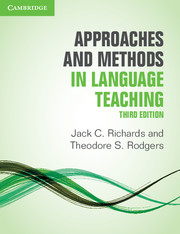Book contents
- Frontmatter
- Contents
- Acknowledgments
- Introduction to the third edition
- I Major trends in twentieth-century language teaching
- II Current approaches and methods
- III Alternative twentieth-century approaches and methods
- IV The teaching and learning environment
- Appendix: Comparison of approaches and methods
- Author index
- Subject index
12 - Multiple Intelligences
Published online by Cambridge University Press: 08 April 2022
- Frontmatter
- Contents
- Acknowledgments
- Introduction to the third edition
- I Major trends in twentieth-century language teaching
- II Current approaches and methods
- III Alternative twentieth-century approaches and methods
- IV The teaching and learning environment
- Appendix: Comparison of approaches and methods
- Author index
- Subject index
Summary
Introduction
A feature of language learning classrooms is the diversity of learners who are often studying in the same class. Diversity refers to the many ways in which learners may differ from one another. They may differ in their motivations for learning English, their beliefs about how best to learn a language, the kinds of strategies they favor, and their preference for differ-ent kinds of teaching methods and classroom activities. Language teaching has often been based on the assumption that “one size fits all,” and some of the teaching approaches and methods described in this book reflect this view of learners. The learner's role in learning has been predetermined and planned in advance, and the learner's role is to adapt him- or herself to the method. Such is the case with methods such as the Silent Way (Chapter 16) and Suggestopedia (Chapter 18). More recent approaches to language teaching seek to acknowl-edge the differences learners bring to learning. Learners are viewed as possessing indi-vidual learning styles, preferences, and strategies, and these influence how they approach classroom learning and the kinds of learning activities they favor or learn most effectively from. Pedagogy is hence assumed to be more successful when these learner differences are acknowledged, analyzed for particular groups of learners, and accommodated in teaching. In both general education and language teaching, a focus on individual differences has been a recurring theme in the last 40 years or so, as seen in such movements or approaches as individualized instruction, autonomous learning, learner training, and learner strategies (see Chapter 19). The theory of Multiple Intelligences shares a number of commonalities with these earlier proposals.
Multiple Intelligences (MI) refers to a learner-based philosophy that characterizes human intelligence as having multiple dimensions that must be acknowledged and devel-oped in education. Traditional intelligence or IQ (Intelligence Quotient) tests are based on a test called the Stanford–Binet, founded on the idea that intelligence is a single, unchanged, inborn capacity. However, traditional IQ tests, while still given to most schoolchildren, are increasingly being challenged by the MI movement. MI is based on the work of Howard Gardner of the Harvard Graduate School of Education (Gardner 1993). Gardner notes that traditional IQ tests mea sure only logic and language, yet the brain has other equally important types of intelligence.
- Type
- Chapter
- Information
- Approaches and Methods in Language Teaching , pp. 230 - 243Publisher: Cambridge University PressPrint publication year: 2014



